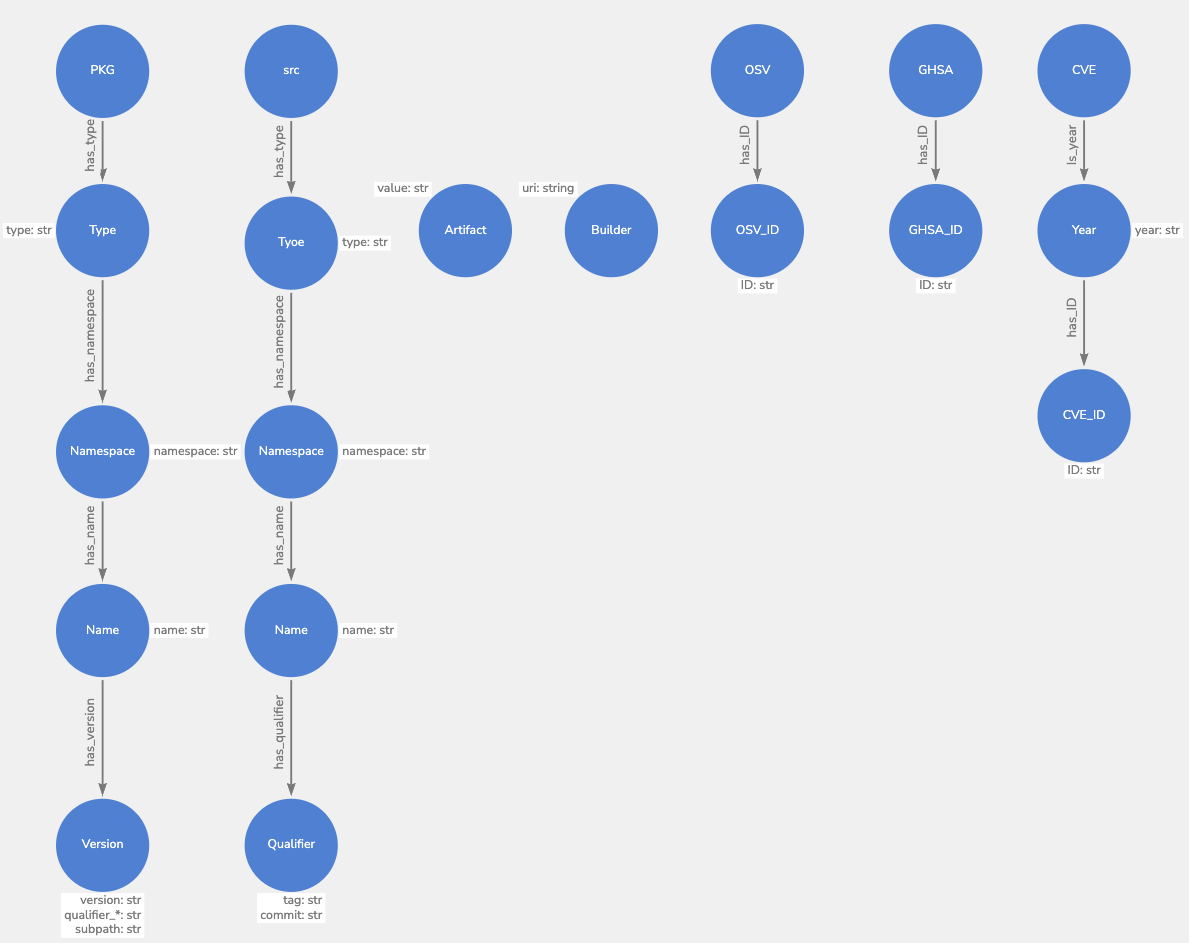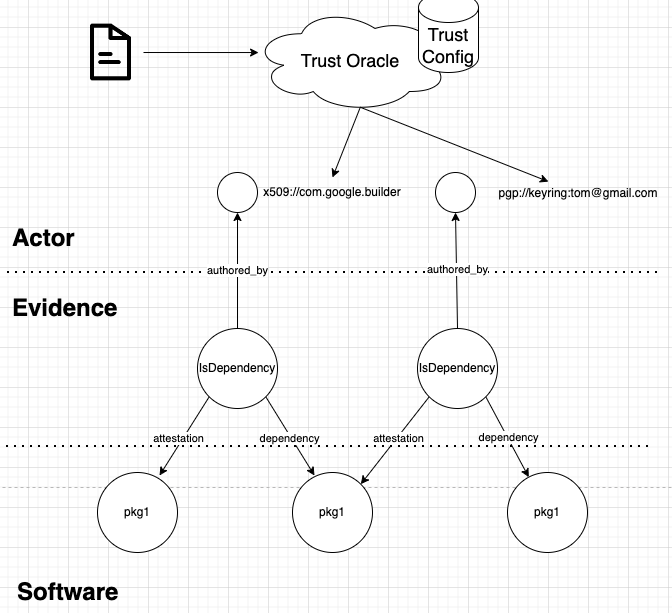GUAC Ontology Definitions
This document provides some insights into how the GUAC ontology was defined.
For a comprehensive and up-to-date listing of the GUAC ontology, please refer to the GraphQL documentation.
Overview
The GUAC Onlotogy document defines the 3 structures as the software tree, evidence tree, and actor tree.
- Software Tree: A factual structure that describes software entities. They communicate both physical (e.g. artifact and hashes) and logical (e.g. pURL) views, and are an extension of the idea of factual software identifiers nodes as described in GUAC Identity Problem Design Doc(Issue #217).
- Evidence Tree: A structure to communicate claims about nodes in a software tree and tie them to the actor tree. All claims are considered skeptical and need to be evaluated based on observing their evidence (through linking with the actor tree).
- Actor Tree: A structure to model trust and trust relationships.
GUAC software tree
We first have to define the software tree and components. This can be broken into: pURL, source, artifact, builder, OSV, GHSA, and CVE.
For a comprehensive and up-to-date listing of the GUAC ontology, please refer to the GraphQL documentation.
Package (Pkg)
This is based on the purl-spec and defined as: scheme:type/namespace/name@version?qualifiers#subpath. The definition for each component is:
- Scheme (Required): The URL scheme with the constant value of “pkg”. One of the primary reasons for this single scheme is to facilitate the future official registration of the “pkg” scheme for package URLs.
- Type (Required): The package “type” or package “protocol” such as maven, npm, nuget, gem, pypi, etc.
- Namespace (Optional): Type-specific, name prefix such as a Maven groupid, a Docker image owner, a GitHub user, or an organization.
- Name (Required): Name of the package.
- Version (Optional): Version of the package.
- Qualifiers (Optional): Type-specific, extra qualifying data for a package such as an OS, architecture, a distro, etc.
- Subpath (Optional): Extra subpath within a package, relative to the package root.
It was decided that mapping to hashes as leaf nodes should not be part of the software tree and should be linked via an attestation/evidence tree. This is due to the fact that saying a package has an occurrence of an artifact with hash is an opinion, and software trees need to remain factual. For example, an SBOM may contain an entry that says “pkg://abc” has hash “sha256:def”, however, this may be incorrect - and thus GUAC providing the ability to raise counterfactuals becomes important if there is a conflict of two trusted document metadata.
Source
Source is used to define the location of the software artifact. Similar to the purl spec this is defined as:
- Type:: Version control system type (git/svn/cvs).
- Namespace: Location of the repo (github/gitlab/bitbucket).
- Name: URL to the repo.
- Qualifier: Tag or commit.
Artifact
Artifact contains the hash of the software component.
Builder
Builder is the component that built the artifact (for example GitHub actions, FRSCA). This contains the URI of the builder.
OSV or Open Source Vulnerability
OSVs contain the OSV ID that can be mapped to a GHSA or CVE.
GHSA - GitHub Security Advisory
GHSA contains a GHSA ID that maps to the GitHub Advisory Database.
CVE - Common Vulnerabilities and Exposures
CVE contains a CVE ID.
A visualization of some of the above software trees would look like:

GUAC Evidence Tree
An evidence tree would then create attestations/actions against nodes of a software tree and link them to each other and to nodes in the actor tree. We note that attestations/actions represented as evidence trees can be overlaid not only on leaf nodes. For example, an attestation may be on all software versions, and thus may be applied upon the software tree representation of the pURL: pkg://pypi/requests, instead of doing it on a particular version number. This also applies to the representation of the source where the name and qualifier (containing the tag/commit) may be used for the attestation.
An example of a predicate is:
IsDependency:
- Description: Attestation that the package has the following dependencies (pkg) based on a justification
- Subject:
- pkg
- Object:
- depends_on ( pkg ) (pkgName)
- Properties:
- justification ( string )
- version_range ( string )
- source ( string )
- collector ( string )
For a list of all predicates, please refer to the GraphQL documentation.
GUAC Actor Tree (Not in v0.1 BETA)
The structure of the trust ontology is one of either delegation (e.g. certificate authorities), or one of a web of trust (e.g. pgp). These were the two topologies of trust that encapsulate the most common trust models.
We determined there to be 3 different dimensions of trust of action:
- Identity: Do I trust verification of the entity that has made this claim?
- Capability: Do I trust the entity to assert that claim?
- Subject: Do I trust that the entity is an authority to such a claim?
Then we decided to start with the following:
- Structure: Only interested in the leaf nodes of a trust ontology.
- Reasoning: We only care about the identity for the GUAC BETA, and capabilities as far as intrinsic protocols allow the expressiveness of (x509 expiry and key capabilities).
The way to do this is to have identity nodes as part of the “Actor Tree” be singletons represented by a URI with information on whether or not they’ve been verified. These URIs would be validated with the root of trust via trust oracle, which would use a trust config per GUAC instance to verify the signatures and provide a URI that can be used to make trust decisions. This is building upon the proposal as in the “Trust Policy” section of this document: GUAC Identity Problem Design Doc, and discussed as part of this issue.
This would look like the following from a topological perspective. However, since they are singleton nodes, they can be stored as URIs in each evidence node and can be de-normalized if there is a need to optimize queries.
